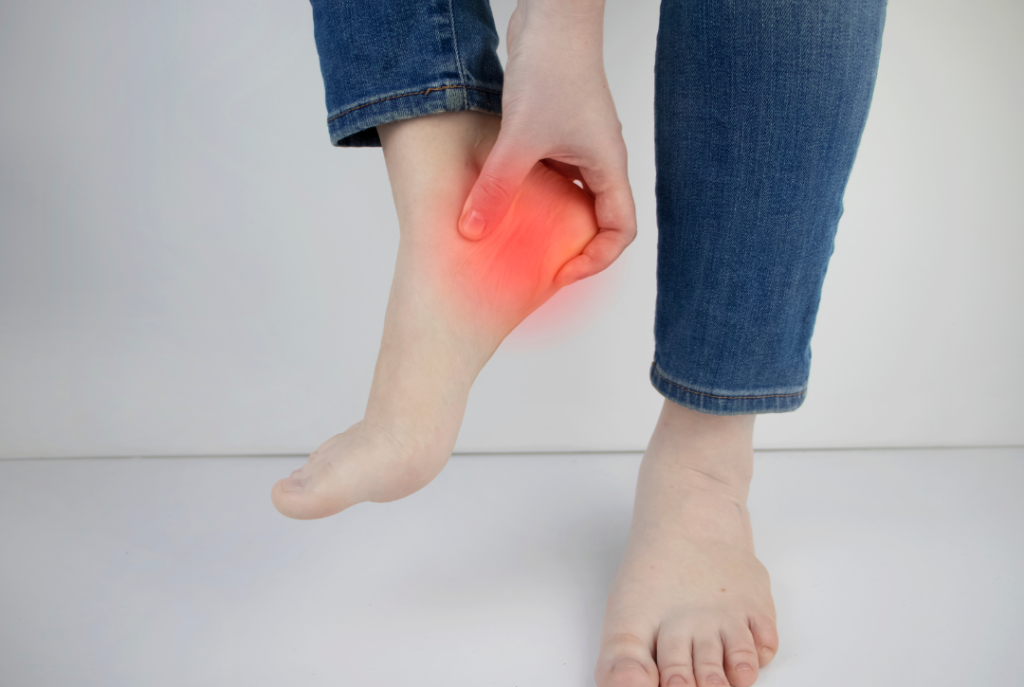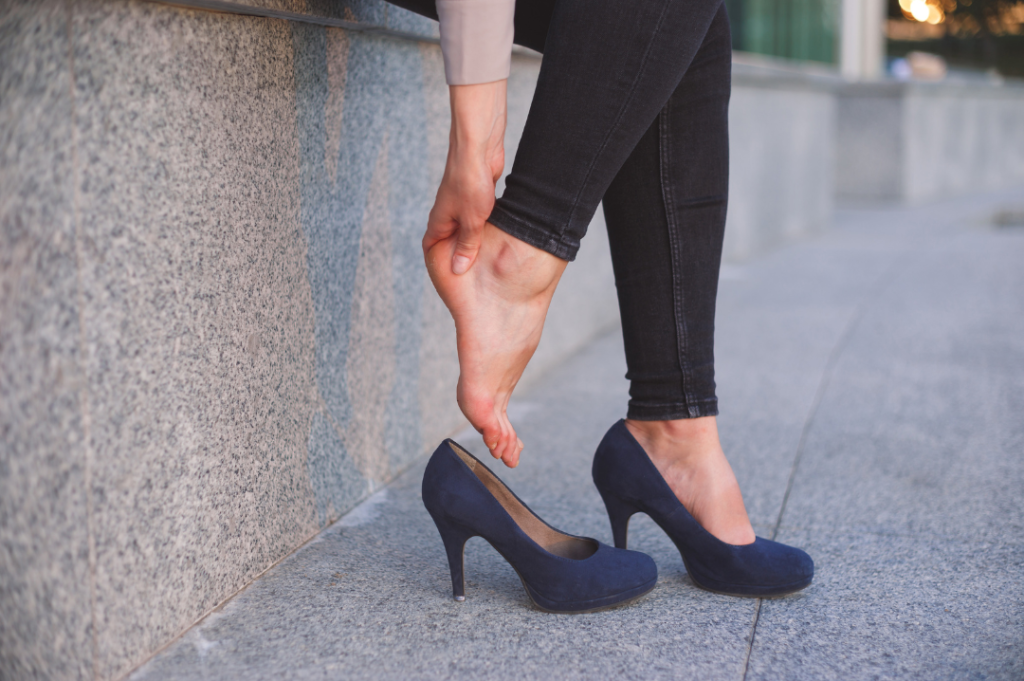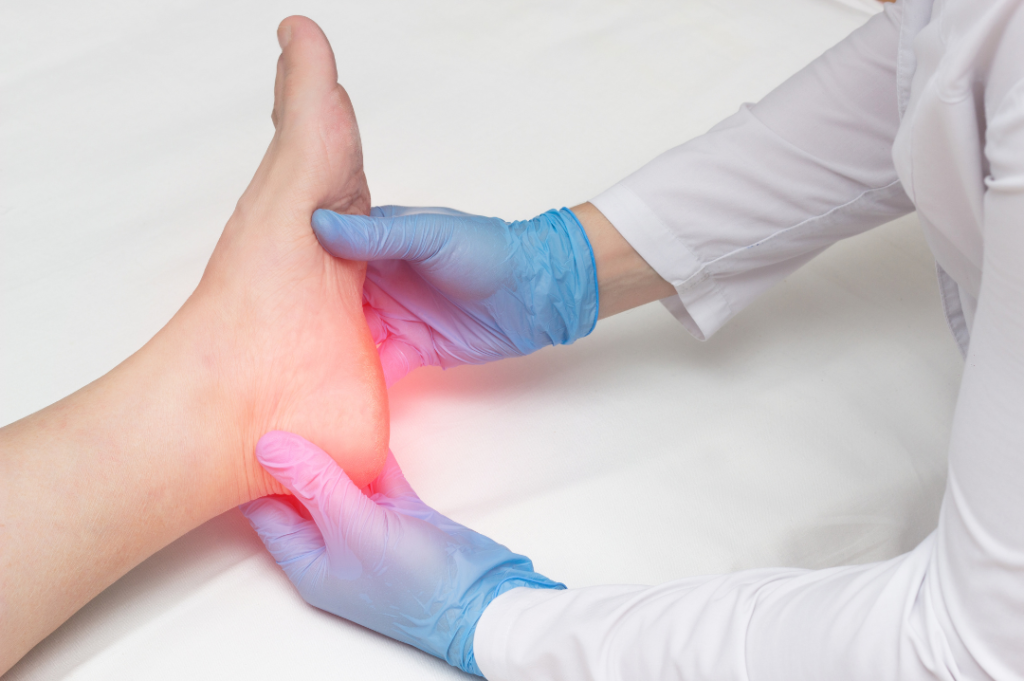 Plantar fasciitis heel pain is one of the most common conditions seen and treated by our podiatrists. It is characterised by that first-step pain at the bottom of the heel in the mornings, which often eases after a short period of walking around.
Plantar fasciitis heel pain is one of the most common conditions seen and treated by our podiatrists. It is characterised by that first-step pain at the bottom of the heel in the mornings, which often eases after a short period of walking around.
Plantar fasciitis heel pain occurs when the plantar fascia, a thick band of tissue that fans out from the heel to the toes, becomes inflamed or damaged. Most often, we see this damage from overdoing it on the feet – which often looks like going too hard, too fast during exercise or having an unexpectedly long day on your feet, paired with poor foot biomechanics like having flat feet that aren’t supported with good footwear. To read more about what causes plantar fasciitis, see here.
How To Cure Plantar Fasciitis At Home
In order to cure plantar fasciitis heel pain, it’s important to both allow the damaged plantar fascia tissue to heal, as well as address the causes of the damage so they don’t continue to strain the plantar fascia further. Things you can do to relieve your symptoms while you’re at home and begin the healing and repair process include:
 Resting and alleviating the painful foot and avoiding activities that aggravate your symptoms. This can help reduce swelling while stopping the damage to the fascia from worsening due to continued overuse.
Resting and alleviating the painful foot and avoiding activities that aggravate your symptoms. This can help reduce swelling while stopping the damage to the fascia from worsening due to continued overuse.
- Applying ice to the affected heel and foot for up to 20 minutes through a towel or other cloth (to prevent the ice from coming into direct contact with the skin), up to 4 times per day. This can help reduce inflammation, and therefore your heel pain.
- Gently stretching the plantar fascia in bed in the morning using a towel can help loosen up the plantar fascia and reduce the first-step pain you feel. In order to do this, keep a towel by your bedside table so that you can reach it without leaving your bed in the morning. Upon waking, get the towel and place the middle of it behind your forefoot, holding each side of the towel with each hand. With your leg full outstretched, gently pull the towel towards you, which will bring your toes and forefoot towards you, stretching the fascia. Hold for 3 seconds and repeat 15 times.
- Wearing supportive shoes with good arch support and cushioning can help alleviate symptoms. We prefer good running shoes from brands like Asics and New Balance among several others. Your local Shoe Clinic or similar shoe store can help you get the best shoe for your foot type.
- Avoiding being in bare feet or jandals, as this is when your plantar fascia must work the hardest.
- Massaging the heel and arch with a tennis ball or foam roller can help relieve pain and tension. Many people also find it comfortable to roll their heel or arch over a cool water bottle for both the stretch and the relief that the cool can bring.
- Using nonsteroidal anti-inflammatory drugs (NSAIDs) such as ibuprofen can help temporarily reduce pain and inflammation
While all of these techniques can be very useful and effective in giving you some relief from your symptoms and, in the case of wearing supportive shoes, setting the scene for healing and repair to begin, it should be noted that these are temporary measures to ease the pain and improve your comfort – not a cure or treatment. This is because none of these measures address the underlying causes of your plantar fasciitis heel pain, which is often attributed to your foot biomechanics that will remain the same and continue to cause the same issues and damage as you continue to walk.
If you do not seek further treatment, it is likely that your heel pain will continue to worsen. Damage and inflammation may progress further to a partial tear in the fascia, which may require more drastic treatment measures like an immobilising moon boot or walker.
How To Cure Plantar Fasciitis Heel Pain For Good
 As mentioned, curing plantar fascia involves addressing all the underlying causes and contributing factors, which are discerned during a comprehensive biomechanical assessment. This assessment, and your treatment plan, should also be considerate of your daily activities, lifestyle and your goals – especially with many of our patients being active and striving towards specific sporting goals.
As mentioned, curing plantar fascia involves addressing all the underlying causes and contributing factors, which are discerned during a comprehensive biomechanical assessment. This assessment, and your treatment plan, should also be considerate of your daily activities, lifestyle and your goals – especially with many of our patients being active and striving towards specific sporting goals.
Once you’ve had plantar fasciitis, you’re more likely to damage your fascia again, so future prevention is a key part of your treatment plan that your podiatrist will consider and discuss with you. Depending on the severity of your symptoms, your treatment may include:
- Foot orthotics: using the measurements and results of your biomechanical exam, our podiatrists can prescribe custom foot orthotics that work to keep your fascia best supported with every step, creating an ideal environment for repair. Orthotics work for the feet in much the same way that prescription glasses work for your eyes.
- Shockwave treatment: shockwave is a safe and effective treatment that is proven to accelerate your healing and recovery from heel pain. Shockwave works by emitting high-energy acoustic wave pulses directly into the injured area. These waves stimulate new blood vessel and collagen formation, increased blood flow for accelerated healing and repair, pain reduction, and resolutions in the build-up of calcium around the heel.
- Foot mobilisation: foot mobilisation uses hands-on manipulation to work on stiff and dysfunctional joints to best support your recovery by facilitating the restoration of healthy movement.
- Footwear review: your regular footwear, both sports shoes and regular shoes or work shoes, will be checked and discussed to make sure they are helping your recovery and not hindering you.
- Dry needling: this uses fine, acupuncture-like needs to target surrounding soft tissues structures to release tension in the muscles, by targeting trigger points, thus easing the strain on the plantar fascia.
- Strapping: strapping can be used as a temporary measure to reduce painful symptoms by keeping your foot in a position that relieves strain and pressure from the plantar fascia.
- Stretching: once the initial pain and inflammation settle and you are able to handle gentle stretching, stretching the fascia can help reduce and prevent the onset of painful symptoms. Because other tight muscles in the feet and legs can pull on the heel and therefore the fascia, stretching will also focus on other tight muscle groups too.
- Strengthening: working to strengthen the muscles of the feet and legs can improve your overall foot and leg function, thereby reducing the risk of injury. Strengthening exercises will be prescribed on a case-by-case basis after reviewing the results of your assessment.
- Exercise review: we’ll make sure the exercise you’re currently doing won’t prolong your recovery or worsen your plantar fasciitis. In some cases, it may be most beneficial to swap higher-intensity activities for lower-impact ones, such as cycling or swimming, allowing you to continue to stay active while you rehabilitate your injury.
